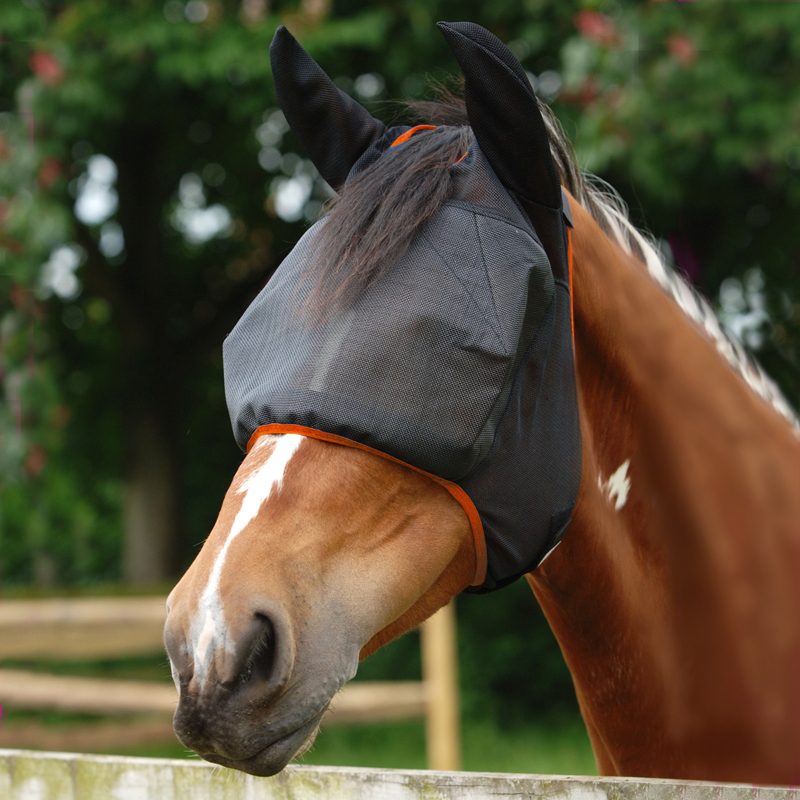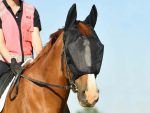1 year product guarantee
Free delivery on most orders over £40
Rated 4.9/5 stars on Feefo

Researched & tested products

Innovating for over 20 years!
Supporting Redwings Horse Sanctuary & Brooke
Feefo Gold Trusted Service Award Winner
Get more time to pay with Klarna
UV in Horse Fly Masks: What You Need to Know
Horse fly masks are a common piece of equipment for horses, but many people don’t realize that they also provide UV protection. In this blog post, we will discuss the importance of UV protection for horses and how horse fly masks can help. We will also provide some tips on choosing the right fly mask for your needs.
UV rays can damage the skin and eyes of horses.
Preventing sunburn. Horses can get sunburned, just like humans. Sunburn can cause pain, inflammation, and even skin cancer. Horses with pink skin are more susceptible to this, however prolonged exposure can still cause damage for all horses.
Protecting the eyes. UV rays can damage the eyes, leading to cataracts, corneal ulcers, and other problems. Just as you might buy sunglasses with UV protection for you own eyes, horse equivalents are available too!
Preventing photosensitization. Photosensitization is a condition that occurs when a horse’s skin is overexposed to UV rays. It can cause the skin to become red, itchy, and painful.
UV and Headshaking.
UV light can be a trigger for headshaking in horses. Headshaking is a condition in which a horse shakes its head violently, often in response to a trigger such as wind, sunlight, or dust. The exact cause of headshaking is unknown, but it is thought to be caused by a combination of factors, including:
- Inflammation of the trigeminal nerve. The trigeminal nerve is the fifth cranial nerve and is responsible for sensation in the face. Inflammation of this nerve can cause pain, which can trigger headshaking.
- Allergies. Allergies to pollen, dust, or other environmental factors can also trigger headshaking.
- Nerve damage. Damage to the nerves in the head and neck can also cause headshaking.
Find out more about headshaking here.
Horse fly masks and rugs can provide UV protection.
Differing levels of UV protection are available. 100% UV is difficult to achieve in a fly mask as these are generally made from mesh to ensure visibility. The holes in the mesh will naturally allow some UV in – however if there weren’t holes it would be unlikely that your horse will be able to see. Fly rugs with UV protection are commonly used not just for flies – but to reduce bleaching to your horses coat caused by the sun’s rays. Think of it like garden furniture which usually has UV resistant fabric. The materials colour would fade much more quickly when left in the sun without any UV protection properties, when compared to UV resistant material.
There are a variety of horse fly masks available, so it is important to choose one that fits well and is comfortable for your horse.
Before choosing a mask for your horse, you should consider your horses full needs – do they have sensitive skin, are they easily irritated, what are the ‘must-have’ features for your fly mask? You might want to just shield their eyes, in which case a mask without ears or a nosepiece might do, however other masks are available offering more coverage if you need it. Other things such as padding, a close fit, the UV rating and protect guarantee are just some of the things you should consider. Read more about choosing the perfect fly mask here.
Category
Advice, Advice, Equilibrium Blog, Equine Ailments, Eyes, Eyes, Headshaking, Horse Care & Equipment, Horse Care & Equipment, Keeping your horse happy, Keeping your horse happy, Skin ConditionsConclusion
Horse fly masks are an important piece of equipment for horses, and they can also provide UV protection. By choosing the right horse fly mask and cleaning it regularly, you can help protect your horse from the harmful effects of UV rays.
Tips:
- Choose a horse fly mask that fits well and is comfortable for your horse.
- Clean your horse fly mask regularly to prevent the build-up of bacteria and mould.
- Replace your horse fly mask if it becomes damaged.
- Apply sunscreen to your horse’s exposed skin, such as its nose, even if they are covered by a horse fly mask.
- Where relevant, horses should be kept in the shade during the hottest part of the day in extreme temperatures. This will help to reduce their exposure to UV rays. Shade, be it natural or artificial, should always be accessible to your horse.
Related Articles
View all articlesHorse Fly Masks – Choose the best fly mask for your horse.
Read articleThe Essential Guide to Choosing the Perfect Fly Mask for Your Horse
Read articleRelated Products
View all products-
 Field Relief Midi Fly Mask (no ears)£26.50 View product
Field Relief Midi Fly Mask (no ears)£26.50 View productField Relief Midi Fly Mask (no ears)
A horse fly mask without ears that ticks all the…
-
 Field Relief Fly Mask Max£34.50 View product
Field Relief Fly Mask Max£34.50 View productField Relief Fly Mask Max
Combining the best protection against summer irritants with exceptional comfort…
-
 Field Relief Midi Fly Mask With Ears£28.50 View product
Field Relief Midi Fly Mask With Ears£28.50 View productField Relief Midi Fly Mask With Ears
A horse fly mask with ears that ticks all the…
-
 Net Relief Riding Mask£24.99 View product
Net Relief Riding Mask£24.99 View productNet Relief Riding Mask
Stress-free summer hacking with this ride on fly mask which…
